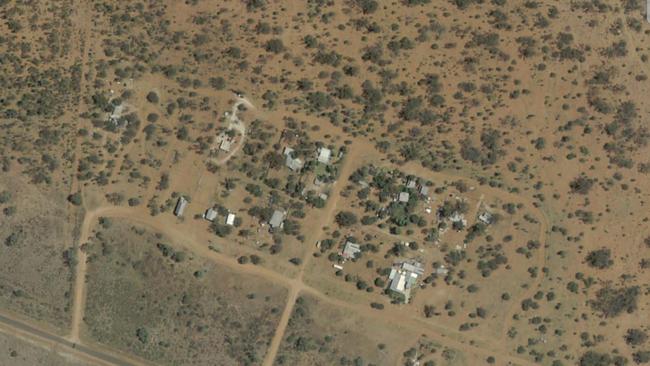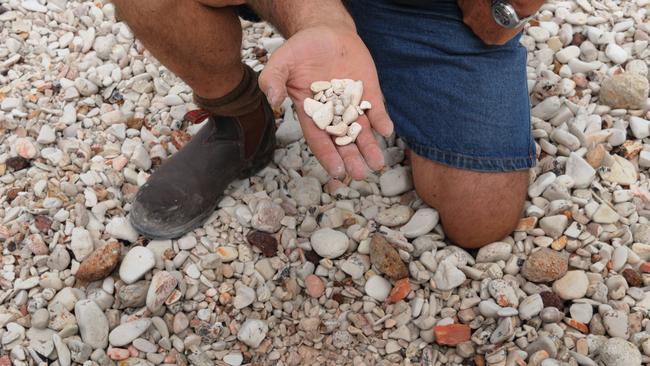The tiny opal town at the centre of the mystery of a dead opal cutter named Martin
The locals at Angledool, population 58, are private folk. It’s all nicknames and first names: an easy place to be anonymous. Which meant the discovery of the body of a local who had been dead for six months was just the beginning of the mystery.
Police & Courts
Don't miss out on the headlines from Police & Courts. Followed categories will be added to My News.
In a tiny outback opal mining town, most locals live off the grid, with very little record of them being there.
They are private folk. Unnecessary questioning about personal lives is frowned upon – small talk is strictly opal business – which has made a bizarre investigation into the death of an opal cutter all the more difficult.
More than eight years after a man known as Martin Siu was found dead at his property in the tiny community of Angledool, NSW Deputy State Coroner Harriet Grahame last month closed the case – but who the opal cutter really is remains a mystery.
Locals knew him as an opal cutter and seller, and that he had lived and worked in Angledool since at least 2004. ‘Martin’ was of Asian heritage, but due to Angledool’s unspoken rules to “mind your business” – no one knew much more than that.
Just 58 people were registered living in the town following the 2016 census, but with makeshift, generator-run camps and off-grid hermits scattered throughout the community, it’s expected many more actually live there.

Sitting near the Mehi opal field just below the Queensland border, Angledool is about 46 kilometres from Lightning Ridge. Unlike another opal town, Coober Pedy, locals don’t live underground, with the earth too crumbly to escape the scorching summer heat.
During Magistrate Graham’s inquest into Martin’s death, Senior Constable Ryan Dale, who was involved in the investigation, admitted authorities don’t know who really lives in the community.
“The record keeping in terms of who lives there is not normal, a lot of generators – so no electricity, no tracking through that way, a lot of people who are indirectly involved go to Lightning Ridge and live very remote lifestyles with very little record of them being there,” he said.
“A lot of people live out there, and we don’t know who’s there.”
Famous for their rich opal mining history, it seems communities near Lightning Ridge are some of the very few places where people can escape to start fresh – where locals most of the time go only by nicknames or first names.
“They might escape out here because of their private life, or the law,” one local said on the condition of anonymity.

“You can be here 30 years and not know your neighbours’ surname, you politely don’t ask. You mind your business.”
The allure of the remote community is deeply rooted in the opal trade, where you can be “broke one minute and a millionaire the next.”
“If you catch the opal bug you stay here for the rest of your life, it’s like a treasure hunt,” another long-time resident said.
“Others might give it a go and leave as quickly as they came.”
A few people in Lightning Ridge told the Sunday Telegraph they knew of Martin Siu’s death, but were unaware of the ongoing quest to identify him – and the fact that until the findings of the inquest this month, his body was being held at a forensic medical facility.

Martin was found dead in August 2015, after his neighbour Judith raised the alarm with police. She had known him for the better part of a decade, and knew Martin was having issues with his eyesight, which was impacting his work with opals, but grew concerned after realising she’d not seen him for six months.
The inquest heard Judith decided to use her spare keys to find out what might have happened to him – letting herself into his property. Inside his home, she found a handwritten note on the back cover of a wall calendar sitting on the coffee table.
THE NOTE
The note had been written in at least two different pens and read in broken English:
“I call police 30/9/14. I am kill myself, call my brother … Siu Wat Leung. Signed by Wa Sang Siu. I got cancel. Bell cancel.”
Judith left the property and immediately called the police, who arrived not long after. Officers searched the property, and found a man’s wallet on the bedside table with a NSW drivers licence in the name of Wa Sang Siu.
Neighbours confirmed that it was Martin’s wallet, and something he never left home without, the inquest heard.
At the back of the property was what can only be described as a typical outhouse. But the corrugated iron structure did not house a toilet, instead, it was a ‘cutting room’, commonly used by opal miners to prepare stones for sale.

Inside, police found Martin’s body, which was in an advanced state of decomposition – believed to have been there for around six months.
Specialist detectives arrived to investigate, and despite the unusual position the body was found in, determined that there were no suspicious circumstances and Martin’s death was a case of self-harm.
But the mystery into Martin’s death only deepened from this point.
All documents, paperwork and the drivers licence found at the Angledool premises led investigators to believe that Martin was also known as Wa Sang Siu, and used “Martin” as an Australian name among friends in the local area.
His apparent suicide note referenced “cancel. Bell cancel”, which detectives eventually deciphered to mean “bowel cancer”, after doctors’ letters recommending an endoscopy were found at Martin’s home.
On the same note, Martin referenced his brother Wat Leung Siu, so detectives sought assistance from Interpol in Canberra to deliver the sad news of his passing to his family in Hong Kong.
All correspondence provided by Hong Kong police suggested that this message had been delivered and that his family had accepted the news of his death.
There was “no reason to doubt the accuracy of the family contact information”, however, when later attempts were made to speak with Martin’s family to obtain DNA evidence to formally confirm Martin’s identity, a problem arose.

Hong Kong Police advised they had discovered that Siu Wa Sang – the man thought to have been Martin – was “very much alive”.
“Hong Kong police interviewed the subjects and confirmed his identity,” Hong Kong authorities advised the NSW police.
“Mr Siu Wa Sang confirmed that he lived in Australia between 1985 and 1996.
“In 1996, he claims that he lost his Hong Kong Driving Licence in Australia but didn’t report it at the time.”
Subsequent checks on Wa Sang Siu’s Hong Kong passport confirmed that a person of this name did in fact depart Sydney on December 8, 1996 to return to Hong Kong and had remained offshore since that time.
IDENTITY PUZZLE
This created real doubt about who Martin was – leading police to a new theory: was Martin using Wa Sang Siu’s identity?
The RMS confirmed that a NSW drivers licence in the name of Wa Sang Siu was first obtained in 1984, while Department of Immigration documents found in Martin’s home included applications prior to 1996 and a photograph used to obtain citizenship.
Investigators began to follow the theory that Martin entered Australia under his real, unknown, name but at some stage may have overstayed his visa.
To remain undetected in Australia, they believed he either stole or bought Wa Sang Siu’s drivers’ licence so that he could take over his identity to remain in the country.
But, according to Magistrate Grahame the suicide note revealed a “compelling” connection between Martin and the Hong Kong family he identified on his suicide note.

They had accepted the news he had died back in 2015 – but by 2022 as the long investigation continued, his supposed family had become uncooperative and refused to provide DNA or further statements.
Hong Kong police also refused to assist.
With no leads left to chase, Magistrate Grahame found police had exhausted all lines of investigation, agreeing that she too was unable to establish his true identity.
“I am unable to properly identify the deceased,” she said in her findings.
“I am satisfied that the deceased was known as “Martin”, Wa Sang Siu and Martin Siu in the Lightning Ridge area in the years before his death.
“While many aspects of this case remain a mystery, I am satisfied that persons closely associated with Martin have been informed of his death, even while they now deny any knowledge of him.”
While Martin’s true identity may never be established, he will be buried or cremated following eight years in a Newcastle forensic facility.
“In my view there should be no further delay in laying Martin to rest and affording his remains the dignity they deserve,” Magistrate Grahame said.
While many small towns would be engrossed in such a mystery, those in Lightning Ridge were hardly surprised, with one more unnamed local aptly saying: “I’m sure it’s not the first time that’s happened here.”





